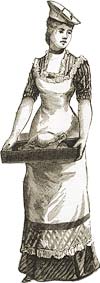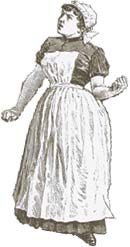Wanted - A respectable woman, of religious character, desired ...
The well-managed Victorian household had a brigade of staff from anywhere between one and forty or more, depending upon the size of the home or estate and the needs of the family.
While wealthy families had the money to hire as many staff as they desired, even the middle class managed to scrape together enough extra money to hire at least one servant.
13% of women in domestic service
Having domestic help was so essential to the social image of the Victorian household that almost 13% of the woman of England and Wales were employed as domestic help during the 19th century.

Regardless of how many servants the household employed, most families followed a logical hiring progression that was designed to ensure that as many domestic tasks as possible had a corresponding person who was responsible for either doing it or seeing that it was done.
A Cinderella in every household
Lowest on the domestic pecking order, and often the first to be staffed, was the "daily girl" or "charwoman". This entry level position was usually filled by a young girl in her teens who was responsible for general housekeeping and heavy cleaning.
From Cassells Household Guide c.1880s
The average pay of a washer woman in and near London is two Shillings per day, provided food and beer be found; and half-a-crown if required to "find herself". A certain quantity of beer or gin is generally stipulated for in the latter case.
Depending upon the size of the domestic staff, she might also have laundry and other responsibilities as well. Think "Cinderella" without the help of the Fairy Godmother.
Table of average yearly wages paid to domestics (1861)
| When not found in Livery | When found in Livery | |
|---|---|---|
| House Steward | £40 to £80 | - |
| Valet | £25 to £50 | £20 to £30 |
| Butler | £25 to £50 | - |
| Cook | £20 to £40 | - |
| Gardener | £20 to £40 | - |
| Footman | £20 to £40 | £15 to £25 |
| Under Butler | £15 to £30 | £15 to £25 |
| Coachman | - | £20 to £35 |
| Groom | £15 to £30 | £12 to £20 |
| Under Footman | - | £12 to £20 |
| Page or Footboy | £8 to £18 | £6 to £14 |
| Stableboy | £6 to £12 | - |
| No allowance for Tea, Sugar and Beer | Allowance for Tea, Sugar and Beer | |
| Housekeeper | £20 to £45 | £18 to £40 |
| Lady's Maid | £12 to £25 | £10 to £20 |
| Head Nurse | £15 to £30 | £13 to £26 |
| Cook | £14 to £30 | £12 to £26 |
| Upper Housemaid | £12 to £20 | £10 to £17 |
| Upper Laundry-maid | £12 to £18 | £10 to £15 |
| Maid-of-all-work | £9 to £14 | £7½ to £11 |
| Under Housemaid | £8 to £12 | £6½ to £10 |
| Still-room Maid | £9 to £14 | £8 to £12 |
| Nursemaid | £8 to £12 | £5 to £10 |
| Under Laundry-maid | £9 to £14 | £8 to £12 |
| Kitchen-maid | £9 to £14 | £8 to £12 |
| Scullery-maid | £5 to £9 | £4 to £8 |
Mrs. Beeton's Book of Household Management, by Isabella Beeton, 1861
The housemaid
The next to be hired would usually be either a housemaid or a nursemaid depending upon the age of the children in the home.
The housemaid would assist with serving meals and guests, "freshening" the parlour, turning down the beds, and helping the Lady of the house with her personal needs.
Sometimes she might even provide domestic services to other house staff of higher rank.
Where the care of small children are concerned a Nurse or nursemaid would have been employed. If possible this post would be filled by someone who came from more highly educated circles of victorian society than that of the domestic servant class.
The nursemaid provided all of the services normally provided by today's nanny. She dressed the children, bathed and fed them, took them outside to play, and acted in like a mother in many ways. In some instances it was actually possible for a "wet nurse" to breast feed infants in some Victorian homes.

Mrs Bridges rules the roost
The next in line to be hired would normally be the cook. The Cook had absolute authority over the kitchen and, in homes where there were no domestic staff beyond the charwoman and a housemaid, was often responsible for supervising and hiring the domestic help as well.
This trio of chargirl, nurse or housemaid and cook was capable of providing a wide range of services to the smaller and less affluent Victorian families. But for larger households, the hiring progression continued with the next in line usually being a male attendant. Depending upon the home, his responsibilities usually ranged from general maintenance, to providing valet services to the Lord of the mansion. He might also double as the stable keeper and drive the carriage as well.
For those households with larger staff needs, domestic staff were selected to fill specialized positions which varied among families. Available positions included a lady's maid, kitchen maid, laundry maid, housekeeper (who automatically became the domestic staff supervisor unless a Butler was hired), groomsman, coachman, footman, a chef and a whole variety of upper and lower parlor maids, chamber maids and more. The very wealthy seemed to have a maid for every reason.
For homes with property (known as "landed estates"), there was always an assortment of groundsmen, gardeners, stable boys and gamekeepers positions available.
The hours were long and the pay was dismal, but there was a sense of pride in being a valued domestic. In fact, many servants spent a lifetime with the same employer and often watched the children grow into the new Lords and Ladies of the Manor.
Sources L. Jackson, The Victorian Dictionary, 29 Sept 2005, <http://www.victorianlondon.org/>